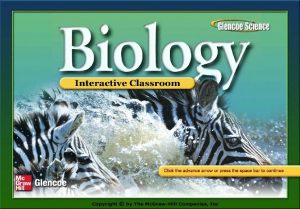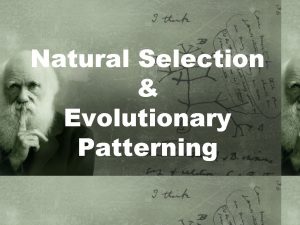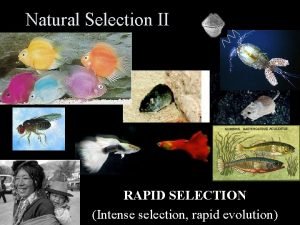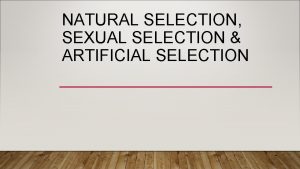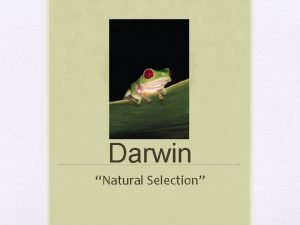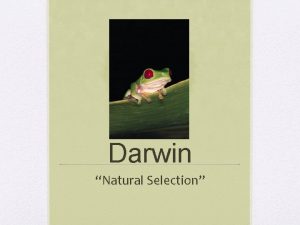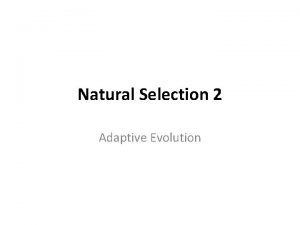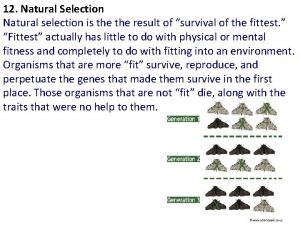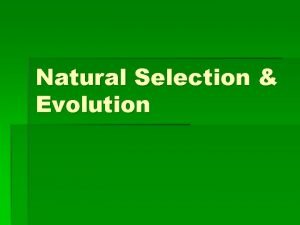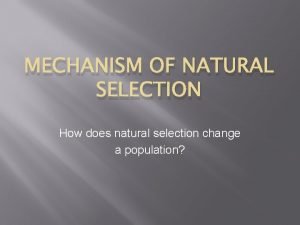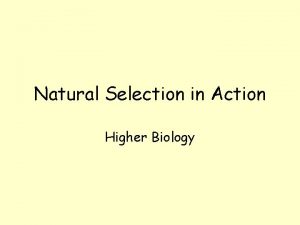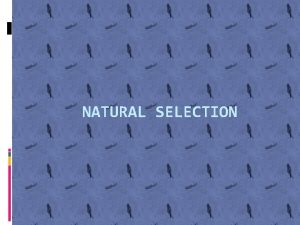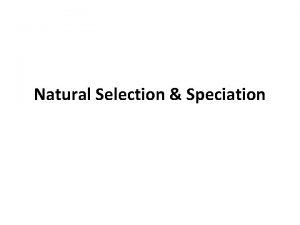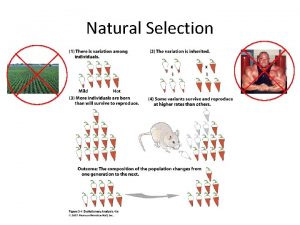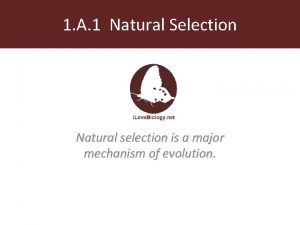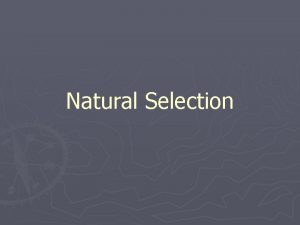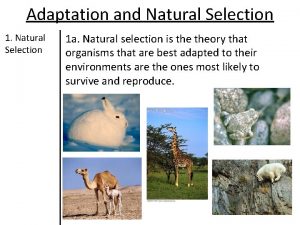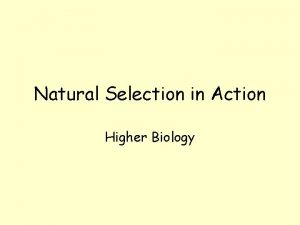Natural Selection Chapter 15 Natural Selection On the








































- Slides: 40

Natural Selection Chapter 15

Natural Selection? • On the following three slides, you will read statements based on student ideas about now natural selection works. Use your clickers to vote for whether you think that the statement IS or is NOT what scientists mean by “natural selection. ”

How Selection Works

1. Variation Exists • All populations vary as the result of the accumulation of _______over many generations.

2. Inheritance of traits • Inheritable traits (those coded for by genes) are passed directly to the offspring from the parents through genetic information.

3. Differential Survival • More offspring are born than can survive. Many offspring die young. Those with traits best suited to the environment are more likely, though not guaranteed, to survive.

4. Differential Reproduction • Some survivors fail to reproduce. Some have traits that better insure reproduction than others.

5. Differential Inheritance • Survivors that reproduce pass some of their traits on to their offspring. Those with favorable traits may pass those favorable traits on — or not.

Natural Selection in Cats • Traits that ensure a domestic cat’s survival among humans: • Endearing qualities: purring, snuggling, being playful, cuteness. • Helpful qualities: rodent control.

• When domestic cats are abandoned: • Most die within a week or two from starvation, accident, or predation. The traits that help them in a domestic setting are useless in the wild. • The few that survive have the strongest feral instincts. • Av. feral lifespan: 2 -4 years

Selection’s Effects Generation 1 Generation 2 Generation 3

As time passes. . . • With each generation, domestic traits are selected against, while feral traits are favored. • After several generations, even kittens that are captured young can be challenging to tame.

Genes and Evolution • Genes are the units of heredity. • Genes are ______that code for proteins, which result in our set of traits. • Genes are passed from parent to offspring through the ________.

• Different “versions” of genes are _____. • Dominant alleles are expressed in the _______ (expressed trait) even if only one copy is inherited. • Recessive alleles are expressed only if _______are inherited. “Genotype” is a description of the alleles for a given trait in an individual: BB, Bb, or bb

Genetic basis of inheritance • _____ - the genetic composition of an organism _____ the specific form of the gene • _______ - the outward expression of genotype • _____________ the total of alleles for all genes in a population BEY 2 gene – controls pigmentation in the eye

You’re probably familiar with genetics in terms of following traits passed from parent to offspring and predicting the outcome. Blackfin shark genotypes in the Gulf of Mexico. http: //www. zoology. siu. edu/heist/blacktip. htm But how do we track traits passed from generation to generation across an entire population? How does population genetics work?

The Gene Pool Concept • The “gene pool” of a population is the entire collection of alleles for a given trait throughout a given population. • The word for all genes for all traits in an individual or population is genome.


Genetic change Mutation, genetic drift, and natural selection will, over time, change the genetics of both populations. Genetic change Causes of Genetic Change in a Population

Hardy-Weinberg Equilibrium • Allele ratios in a gene pool will NOT change from generation to generation (that is, no evolution) ONLY if ALL of these things are true: • ___________________ • __________

Mutations • Small mutations appear randomly in populations. • The appearance of mutations changes allele ratios by • “breaking” functional alleles (as in genetic disorders) • adding new alleles

• Copy errors are rare, but given that genes are copied millions of times in a lifetime, errors can occur. • _____ in the environment can increase the error rate. • Small errors can create _______.

Population size • In large populations, random events have a very small effect. • In small populations, because fewer individuals have any given trait, random events can have a larger effect. Changes in gene ratios caused by random events are called “_________. ”


A population bottleneck is genetic drift.

Founder effect is genetic drift.

Migration • Migration into and out of a population can change gene ratios. • Immigrants can bring in new mutations, or a different ratio of alleles. • Emigrants may take away a high proportion of a certain allele. • Small population are more affected than large populations.

Migration can lead to Founders Effect: Surtsey, Iceland Surfaced 14 Nov 1963 Moss: 1967 Puffin nests: 2004

Selection • Selection may increase or decrease the frequency of certain alleles: • Directional selection: favors one end of a range over another. • Disruptive selection: disfavors the midrange. • Stabilizing selection: favors the mid-range.


Natural selection: Differential survival. Peppered moth Changes allele frequency.

Mating Behavior • Mate choice among most organisms is selective, not random. • ________may favor traits that are in conflict with natural selection. For example, bright-colored male guppies attract more females, but are also more visible to predators.


Sexual selection: competition to mate Widow bird (text E 1 -2 pg 7)

We can measure phenotype Number of males with different tail lengths in a population of redcollared widowbirds. Data based on Pryke and Andersson 2002.

Antibiotic Resistance • Antibiotic resistance has been an increasing problem since the 1970 s. • How does natural selection contribute to the rise in antibiotic-resistant bacteria? (Note it is bacteria that become resistant, not people. Bacteria do not become “immune” — they do not have immune systems. )


Helicobacter pylori is a bacteria that causes stomach ulcers. Most H. pylori bacteria, when encountering an antibiotic, metabolize it with an enzyme that turns it to a toxin. A few H. pylori bacteria have a mutation that interferes with the production of the enzyme. The mutant bacteria aren’t affected by antibiotics.

Evolution Happens • Because perfect Hardy-Weinberg equilibrium is never met with in nature, all populations experience small shifts in gene ratios with each generation. • Gene ratio shifts may fluctuate with cyclical changes in climate. Long-term changes in habitat (such as global climate change) can shift the gene ratios far enough to bring about speciation.

Recap • Natural Selection is a phenomenon that can be studied directly. • Natural Selection causes change in the genetics of a population over generations (evolution). • Other factors that can change genetics of a population include migration, sexual selection, mutations, and effects of random events in small populations.
 Similarities
Similarities Natural selection vs artificial selection
Natural selection vs artificial selection Artificial selection vs natural selection
Artificial selection vs natural selection 5 points of natural selection
5 points of natural selection Natural selection vs artificial selection
Natural selection vs artificial selection Chapter 15 section 1 darwins theory of natural selection
Chapter 15 section 1 darwins theory of natural selection Hình ảnh bộ gõ cơ thể búng tay
Hình ảnh bộ gõ cơ thể búng tay Bổ thể
Bổ thể Tỉ lệ cơ thể trẻ em
Tỉ lệ cơ thể trẻ em Chó sói
Chó sói Tư thế worm breton
Tư thế worm breton Chúa sống lại
Chúa sống lại Các môn thể thao bắt đầu bằng tiếng bóng
Các môn thể thao bắt đầu bằng tiếng bóng Thế nào là hệ số cao nhất
Thế nào là hệ số cao nhất Các châu lục và đại dương trên thế giới
Các châu lục và đại dương trên thế giới Công của trọng lực
Công của trọng lực Trời xanh đây là của chúng ta thể thơ
Trời xanh đây là của chúng ta thể thơ Cách giải mật thư tọa độ
Cách giải mật thư tọa độ 101012 bằng
101012 bằng Phản ứng thế ankan
Phản ứng thế ankan Các châu lục và đại dương trên thế giới
Các châu lục và đại dương trên thế giới Thể thơ truyền thống
Thể thơ truyền thống Quá trình desamine hóa có thể tạo ra
Quá trình desamine hóa có thể tạo ra Một số thể thơ truyền thống
Một số thể thơ truyền thống Cái miệng xinh xinh thế chỉ nói điều hay thôi
Cái miệng xinh xinh thế chỉ nói điều hay thôi Vẽ hình chiếu vuông góc của vật thể sau
Vẽ hình chiếu vuông góc của vật thể sau Biện pháp chống mỏi cơ
Biện pháp chống mỏi cơ đặc điểm cơ thể của người tối cổ
đặc điểm cơ thể của người tối cổ Thế nào là giọng cùng tên? *
Thế nào là giọng cùng tên? * Vẽ hình chiếu đứng bằng cạnh của vật thể
Vẽ hình chiếu đứng bằng cạnh của vật thể Fecboak
Fecboak Thẻ vin
Thẻ vin đại từ thay thế
đại từ thay thế điện thế nghỉ
điện thế nghỉ Tư thế ngồi viết
Tư thế ngồi viết Diễn thế sinh thái là
Diễn thế sinh thái là Dot
Dot Các số nguyên tố là gì
Các số nguyên tố là gì Tư thế ngồi viết
Tư thế ngồi viết Lời thề hippocrates
Lời thề hippocrates





